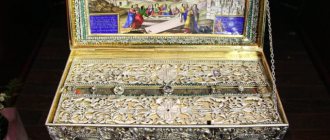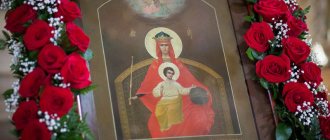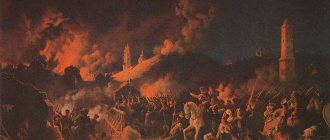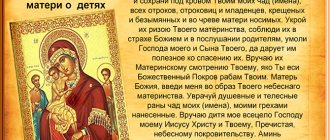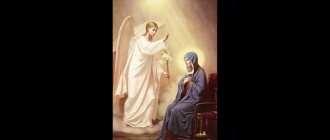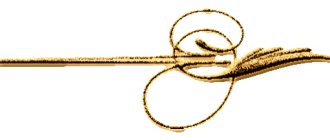The icon “Assumption of the Blessed Virgin Mary” is dedicated to the events that took place during the earthly existence of the Mother of God. In memory of the day when the Virgin Mary left our world, the Orthodox Church established the twelfth holiday. In accordance with the new style, it is customary to celebrate it on August 28 (according to the old style - on August 15). The date, with the advent of which the entire Christian world remembers the Dormition of the Most Pure Mother of God, is accompanied by one day of forefeast and 8 days of veneration.
How did the Dormition of the Virgin Mary take place?
The Dormition, which signifies the death of the Virgin Mary, Her departure from the human world to the Kingdom of Heaven, is not described in the Bible. Information about this event, which is of great importance for all believers, has been preserved in church traditions and apocrypha.
According to ancient scriptures, three days before the death of the Virgin Mary, the Archangel Gabriel appeared. The heavenly messenger said that very soon She would go to Jesus Christ. The Most Holy Virgin began to prepare for the transition to eternity and say goodbye to the people devoted to Her.
Three days were not enough to see all the apostles, since some of them were at a great distance at that time. The Mother of God began to pray to her Son for help, after which a miracle happened: those who preached in distant lands were transported by angels by air to Jerusalem, to the very house of the Virgin Mary.
On the day of her death, the Mother of God lay peacefully on her bed, surrounded by her closest people. Soon the upper room was illuminated with the light of Divine glory, and all those present saw Christ, who took with him the soul of the Mother of God.
The Mother of God was buried in the place where Her parents Joachim and Anna, as well as her betrothed Joseph, had previously been buried. According to legend, one Jewish priest named Afonia decided to turn over the bed of the Mother of God during the funeral procession, but immediately suffered the well-deserved punishment: an angel with a sword appeared to the wicked man and cut off both his hands. The priest was ashamed of his intentions, then believed in One God and became a Christian.
On the third day after the funeral, the Apostle Thomas arrived in Jerusalem. He was very upset because he did not have time to say goodbye to the Most Pure Virgin. Arriving at the cave where the body of the Mother of God was left, Thomas and other disciples of Christ saw an empty tomb. On the same day, during the evening meal, the Mother of God appeared to the apostles and said: “Rejoice! I am with you all the days.”
history of the holiday
The Dormition of the Blessed Virgin Mary is one of the main Mother of God feasts of the Church.
Some data indicate a connection between this holiday and the most ancient celebration of the Theotokos - the “Cathedral of the Most Holy Theotokos”, which to this day takes place on the day after the Nativity of Christ. So, in the Coptic calendar of the 7th century. On January 16, that is, shortly after the Epiphany, the “birth of the Lady Mary” is celebrated, and in the calendar c. on the same date - “the death and resurrection of the Mother of God” (in the monuments of the Coptic and Abyssinian Churches of the 14th century, which, due to their isolation, preserved ancient liturgical practice, January 16 commemorates the Assumption, and August 16 - the Ascension of the Mother of God into heaven).
In the Greek Churches, reliable evidence of this holiday has been known since the century, when, according to the testimony of the late Byzantine historian Nicephorus Callistus (XIV century), Emperor Mauritius (592–602) ordered the celebration of the Dormition on August 15 (for the Western Church we have evidence not - th, and v. - the sacramentary of Pope Gelasius I). Nevertheless, we can talk about the earlier existence of the Feast of the Assumption, for example, in Constantinople, where already in the century. there were many churches dedicated to the Mother of God. One of them is Blachernae, built by Empress Pulcheria. Here she laid the funeral shrouds (robe) of the Mother of God. Archbishop Sergius (Spassky) in his “Complete month-book of the East” points out that, according to the testimony of the Verse Prologue (an ancient month-book in verse), the Dormition was celebrated in Blachernae on August 15 and that the testimony of Nicephorus should be understood in a special way: Mauritius only made the holiday more solemn. Since the 8th century. we have numerous testimonies about the holiday that allow us to trace its history up to the present time.
The appearance of a sacred painting
The history of the creation of paintings depicting the Dormition of the Mother of God begins in the 9th century. This period is known in history as the time when the Christian Church managed to overcome heretical tendencies, defend the right to venerate icons and consolidate many important provisions. When the era of iconoclasm ended, the Feast of the Assumption was finally formed and began to be actively depicted by artists.
At first, the sacred paintings looked quite simple and concise. Early paintings were distinguished by their simplicity, the presence of a small number of figures and details. The very first images of the Assumption include relief compositions and book miniatures. Portable icons and temple paintings that appeared later allowed the masters to significantly enrich the religious plot, making it more expressive and rich.
In the 13th century. The iconography of the Assumption reached its peak development. During this period, the image was fully formed, which later became canonical. Since then, practically no changes have been made to it, with the exception of small details.
One of the most famous works is the composition of Theophanes the Greek, created around 1390. Such a painting, which is a double-sided canvas, later gave rise to the tradition of creating icons with images on both surfaces.
Description of the composition
Most of the icons of the Assumption have significant similarities with each other.
- The central part of the composition always depicts the Mother of God lying on her deathbed with a serene expression on her face and closed eyes, dressed in clothes of muted tones. Her body often looks a little ephemeral - this technique is used to emphasize the unearthly nature of the events taking place.
- At the head of the bier there are the apostles who appeared to bid farewell to the Mother of God. The painting always depicts John the Theologian, to whom Christ, being crucified on the cross, pointed to the Virgin Mary and said: “Behold your mother.” At the same time, the Savior implied spiritual kinship and veneration of the Mother of God as the closest person. Next to John is depicted Peter, fumigating the bed with incense. The painting also contains images of Luke, Bartholomew, Mark, and Matthew.
- Near the dying Mother of God the figures of Dionysius the Areopagite and Ignatius the God-Bearer are visible. These saints are present on most of the icons of the Assumption, since they are the ones who have written evidence of the great event.
- Behind the bed is Jesus Christ, holding in his hands a small figurine of a newborn with a halo. This detail symbolizes the purest soul of the Mother of God, for whom Her Son came. The Savior is often depicted in a blue sphere. Along with him in this symbol of the Heavenly Kingdom are visible cherubs.
All events take place in a room in which there are arches, columns, and windows. Sometimes the painting depicts a more modest interior - two pillars and a cloth hanging on them. In front of the bed there is often a burning candle, symbolizing the end of the earthly life of the Mother of God.
Additional details and meaning of the relic
Some versions of the icon contain images of two figures located in the lower part of the canvas, under the bed of the Blessed Virgin. Most often it is an angel with a sword and a person depicting a prayer gesture. They are mainly associated with an episode that occurred during the burial of the Queen of Heaven. The praying man is the same priest Athos who doubted the holiness of the Mother of God and intended to desecrate the funeral rite, for which he was punished by the heavenly messenger. In some compositions, his severed wrists are depicted hanging on the edge of the bed, and the Jewish priest himself stands away from the bed.
Orthodox Christians claim that the painting, dedicated to the events of the Dormition of the Virgin Mary, contains a very important truth about life and death for all believers. The shrine reminds us that physical death is not a final ending and a state of non-existence. What is depicted on the icon testifies that after the end of earthly life, a person continues to exist in the bright Heavenly world. It should be remembered that the path to it involves sorrow and possible persecution, but at the end of all suffering the believer will certainly find eternal bliss in the Kingdom of God, surrounded by the righteous, saints and archangels of the Lord.
Famous images
There are very many icons dedicated to this holiday; they are highly revered by believers. It is impossible to list even some of them, so we will focus on the list of the most famous of them.
- The miraculous image, painted in 1147, became famous for the deliverance of the city of Pskov in 1581 from the Polish king Stefan Batory, and in 1812, which protected it from Napoleon.
- Kiev-Pecherskaya, ancient, handed over, according to legend, by the Mother of God Herself to Byzantine architects, who in 1075 presented it to Anthony and Theodosius of Pechersk,
- Pskov-Pecherskaya also saved Pskov from Batory in 1581,
- Pyukhtitsa, found at the roots of an oak tree near the holy spring,
- Semigorodnaya, works by Rev. Dionisy Glushitsky, transferred to the deep forests of the Semigrad volost,
- Dalmatskaya, named after the founder of the Assumption Monastery near Perm.
The work of Theophanes the Greek
This image was painted by the great icon painter in the 1390s. This is a very laconic image; the artist does not draw attention to details, but focuses on the main events and figures. In the center is our Lord Jesus Christ, surrounded by a dark mandorla, holding in both hands the Soul of His Mother in the form of a swaddled baby.
At the edges of this Glory stand two apostles with the Gospels slightly open: James, the brother of the Lord, and Hierotheus of Athens. Near the bed we see almost all the apostles. The icon painter does not depict them flying on a cloud, but simply places them next to the bed of the Most Pure One. They all mourn the upcoming separation. There is a lit candle in front of the bed.
There is no host of angels, no purple shoes are visible, no plot with the cutting off of Athos’ hands. Everything is subordinated to the main idea, the spirit of this event is perfectly conveyed: sorrow and greatness, sadness and joy.
What prayers are read before the icon of the Assumption?
Orthodox Christians pray at the icon of the Dormition to receive help from the Most Pure Virgin with illnesses, mental anguish, injustice, and slander. Prayer to the Queen of Heaven through Her bright image gives strength in the fight against addictions, allows you to find a way out of complicated situations, resist the machinations of enemies, and receive protection for your home and family from evil people and dark magical spells. The Mother of God provides support to mothers who come to Her with requests for the well-being of their children and to guide them on the righteous path.
The icon of the Assumption is used by clergy to give farewell to the seriously ill and dying. Together with the reading of special prayers, it helps to cleanse the soul of a person who is preparing to soon leave the earthly world and enter the Kingdom of the Lord after the death of the physical body.
What do they pray for when turning to the image, how does it help?
The Icon of the Assumption is very strong in overcoming the fear of death; it reflects the true, correct understanding of death - the transition to a future existence, joyful for a real, faithful Christian. In addition, the following petitions are offered before this icon:
- About healing illnesses, mental and physical,
- About strengthening faith,
- About overcoming sins and destructive passions,
- About getting rid of slander,
- As a farewell to the dying,
- About giving wisdom to make an important decision.
Of course, you can and should pray to this icon in other adversities, in any difficult circumstances - with faith and love.
At all times, icon painters with reverence and love created handwritten icons, frescoes, and wall paintings of the Assumption. The theme revealed in this holiday - overcoming the fear of death, expecting a pious death, a joyful exodus into Eternity - is very close to true Christian believers. That is why icons created for the sake of this holiday enjoy such worship...
Alexander Borisovich
